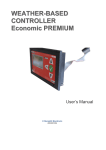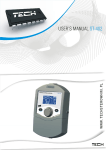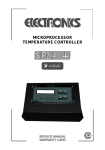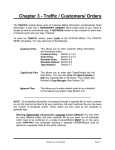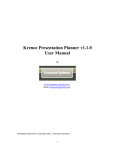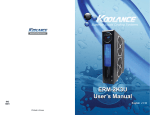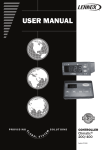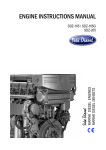Download ST-408N - Kotly.com.pl
Transcript
Tech -1- ST-408N – user's manual Declaration of Confirmity No. 86/2013 Hereby, we declare under sole responsibility that the ST-408N 230V 50Hz thermoregulator manufactured by TECH, headquartered in Wieprz 1047A, 34-122 Wieprz, is compliant with the Regulation by the Ministry of Economy. (Journal of Laws Dz.U. 155 Item 1089) of July 21, 2007 implementing provisions of the Low Voltage Directive (LVD) 2006/95/EC of January 16, 2007. The ST-408N electromagnetic controller compatibility has (EMC) been with tested optimal for loads applied. For compliance assessment, harmonized standards were used: PN-EN 60730-2-9:2011, PN-EN 60730-1:2012. Marked product CE: 04/2013. Wieprz, 23 IV 2013 -2- Tech -3- ST-408N – user's manual I. Use ST-408N thermoregulator is intended for controlling central heating installation. The controller supports two mixing valves, DHW pump (of water boiler), circulating pump and a solar collector. The controller may cooperate with two ST-61 modules, which enables the user to control the total of five mixing valves. The controller features weather control and weekly control functions and it may support three two-state (standard) room regulators and one TECH regulator. The device has one voltage contact (additional contact 1) and two dry contacts (additional contacts 2 and 3). It is also compatible with GSM module and Internet module. Return temperature protection is another asset of the device. It prevents the water in the short circulation from boiling and ensures that the temperature of water returning to the CH boiler is not too low. II.Principle of operation Controller operation involves mixing the hot circulating water with the water returning from the heating circuit in order to reach and maintain the set temperature. Pumps which are connected to each valve circuit help to distribute the water throughout the system. A pump should be connected behind the mixing valve whereas the temperature sensor should be placed behind both the pump and the valve in order to ensure accurate measurement of the valve output temperature. Note: if the valve controller and the CH boiler controller operate simultaneously in one circuit, the pump may be connected from the CH boiler controller (the pump output in the ST-408N regulator and in the additional module remains unconnected) The device is controlled using a touch screen. II.a) Main page During normal operation, the graphic display of the regulator shows the main page, which may differ depending on user's settings. The main screen shows the following information: • current and set temperatures of the active valves, • current and set temperature of the water boiler • current and set temperature of the buffer • outdoor temperature • time and day of the week • operation mode of the pumps The screen view shown above is the default one in ST-408N controllers. The user may also switch to panel screen: -4- Tech III. Main menu III.a) Valve 1 In this submenu the user may adjust the basic settings of the first valve. III.a.1) Set temperature This option is used to set the desired temperature which will be maintained by the first valve. The temperature may be adjusted in the main screen, when Temp 1 is active. During proper operation, the temperature of water behind the valve be approaching the set temperature of the valve. III.a.2) Activated This option is used to activate valve 1. When the valve is turned off, the pump is also inactive. After connecting the controller to the power source, the valve is always calibrated, even if it is deactivated. It prevents the valve from remaining in dangerous position. III.a.3) Calibration of the valve This function enables the user to calibrate the first valve at any time. During this process the valve is restored to its safe position – in the case of CH valve it is fully -5- ST-408N – user's manual opened whereas in the case of floor valve it is closed. III.b) Valve 2 In this submenu the user adjusts the basic parameters of the second valve similarly as in the case of valve 1. III.c) DHW pump (of the water boiler) This function enables the user to adjust the parameters of DHW pump operation. III.c.1) DHW set temperature This function is used to adjust the set temperature of domestic water. It may be done in the main screen of the controller when DHW view is active. After the water in the water boiler reaches this temperature, the controller switches off the DHW pump. The pump will be enabled again when the temperature drops below the set value minus DHW hysteresis. III.c.2) Operation modes This function enables the user to switch off the DHW pump if it is not used, or to activate automatic operation (the pump operates according to parameters described in the following section). III.c.3) DHW hysteresis This option is used to set the hysteresis of the water boiler set temperature. It is the difference between the set temperature (desired temp. of the water boiler) and the temperature of returning to operation mode. For example, if the set temperature is 55°C and the hysteresis value is 5 °C, the DHW pump is switched off when the set temperature of 55°C is reached, and it is activated again when the temperature drops to 50°C. -6- Tech III.c.4)DHW pump activation threshold This option is used to set the temperature of DHW pump activation (it is the temperature measured by the CH boiler sensor). When the temperature remains below this value, the pump is inactive, whereas when the temperature is above this value, the pump is switched on and works until the set temperature is reached. III.c.5) Weekly control (of the DHW pump) This function is used to program daily changes of the water boiler temperature. The range of set temperature deviation is +/- 100C. Weekly control is explained in detail in section IV.d.17. III.c.6) Maximum temperature This function is used to set the maximum DHW temperature. After it has been reached, the DHW pump is switched off. III.c.7) Sensor This function enables the user to choose the sensor which will serve as the DHW sensor. III.d) Circulating pump This function is used to control the pump which mixes hot water between the CH boiler and DHW receivers. After activating this function the user sets the 24-hour cycle of pump pause and activation (with the accuracy of 30 minutes). In order to make setting the 24-hour cycle easier, the user may copy a selected time interval into the next one. After the operation plan is defined, the user sets the pump operation time and the pump pause time while the previously selected time interval is active. The user may easily delete the previously saved settings in order to introduce new intervals. -7- ST-408N – user's manual III.d) Operation modes In this function the user may choose one of the three operation modes available. III.d.1) Water boiler priority In this mode, the DHW pump is activated first and it operates until the set DHW temperature is reached (the valves close completely and the valve pumps are switched off). After the set temperature has been reached, the pump is switched off and the mixing valves are activated (along with the pumps – according to their settings). The valves operate continuously until the water boiler temperature drops below the set value minus hysteresis. Then, the valve pumps are switched off and the DHW pump is switched on. III.d.2) Parallel pumps In this mode, all active pumps and valves operate simultaneously. The valves maintain the set temperature and the water boiler is heated to the set temperature. III.d.3) Summer mode In this mode, the CH valves are closed to prevent unnecessary house heating. In the case when the CH boiler temperature is too high, the valve will b e opened as an emergency procedure (requires activation of return protection!) In this mode the water boiler pump and the floor valves operate normally according to their settings. -8- Tech III.e) Manual mode When the manual mode option is selected, the user can open and close the valves (and the auxiliary valves if they are active) manually. It is also possible to switch on/off each valve pump, DHW pump, circulating pump as well as the additional contacts in order to check if the device works properly. III.f) Time Time option enables the user to set the current time and day of the week. Setting the time is essential for weekly control to operate correctly. III.g) Fitter's menu The following sections provide detailed information on all functions which are available in the fitter's menu. III.e) Screen After selecting Screen option, the user may customize the main screen settings. -9- ST-408N – user's manual III.e.1) Screen view With this function the user can change the screen view switching between panel screen and installation screen. III.e.2) At night By selecting At night option the user enters the panel enabling him/her to adjust the screen view at night: As at daytime, Timer or Switched off. The set screen is activated during nighttime, after the screen has not been touched for 20 seconds. In order to return to the main menu, touch the screen. III.e.3) Night from and Day from In the following part of the menu the user may set the exact time of entering night mode (Night from) and returning to day mode (Day from). III.e.4)Brightness during the day and Brightness at night This part of menu enables the user to adjust the screen brightness for both night and day modes. III.f) Language selection - 10 - Tech Here the user may choose the language version of the controller. III.g) Software information When this option is selected, the display shows the logo of the CH boiler manufacturer as well as the software version used in the regulator. III.h) Protection After selecting Protection icon, the main menu shows a panel enabling the user to adjust the settings of the parental lock. When Auto-lock is selected, a panel used for activating and deactivating the lock appears on the screen. In order to set the PIN code, which is essential to operate the controller when the lock is active, press PIN code icon. III.i)Service menu In order to enter the service menu of the ST-408N controller, enter a 4-digit code. The code is available in TECH company. IV.Fitter's menu IV.a) Pump Anti-stop When this function is active, the valve pump is switched on for 2 minutes every 10 days. It prevents water in the installation from stagnation outside the heating season. - 11 - ST-408N – user's manual IV.b) TECH regulator This option allows the user to switch on/off the function of TECH room regulator (e.g. ST-280 or ST-298). In order for the regulator to cooperate with the right valve, the user should activate this type of room regulator and choose an appropriate operation mode in the valve menu. TECH regulator supports RS communication and it is connected to the controller with a four-core cable (RJ12 telephone-type plugs). If TECH room regulator is switched on, apart from room temperature regulation, the user may adjust the set temperature of the active valves and the water boiler directly from the room regulator, without having to go to the boiler room. Another asset of the device is that it enables the user to view the history of temperatures in the form of clear graphs. Moreover, all controller alarms are signalled. The user may also check the outdoor temperature (in cooperation with ST-61 valve module) and set the weekly program. IV.c) Additional contact 1, 2 and 3 This option allows the user to activate-deactivate an additional contact. Contact 1 is connected to the 230V output whereas contacts 2 and 3 are connected to dry outputs. IV.c.1) CH This option should be selected if e.g. the CH pump is connected to the controller • - 12 - Activation threshold – this option is used to set the temperature of device Tech • • activation. When the temperature is below the set value, the device is inactive whereas when the temperature exceeds this value, the device is enabled. Hysteresis – the temperature difference between device activation and its deactivation (e.g. when the activation threshold is set to 60ºC and the hysteresis value is 3ºC, the device will be activated when the temperature reaches 60ºC and it will be disabled when the temperature drops to 57ºC). Sensor – this option is used to select which sensor will provide temperature information needed for the operation of the device connected to the additional contact. IV.c.2) DHW This option should be selected when DHW pump is connected to the controller. • • • • • • Activation threshold – this option is used to set the temperature of device activation. When the temperature is below the set value, the device is inactive whereas when the temperature exceeds this value, the device is enabled and operates until the set temperature is reached. Hysteresis – this option is used to set the hysteresis of the set temperature. After the set temperature is reached, the device is switched off. It is switched on again after the temperature on the sensor drops below the set temperature minus hysteresis value (e.g. when the set temperature is 60ºC and the hysteresis value is 3ºC, the device will be switched off when the temperature reaches 60ºC and it will return to operation when the temperature drops to 57ºC). Set temperature - This option is used to define the set temperature. Maximum temperature – this option is used to set the maximum temperature – when this temperature is reached, the device is switched off. Sensor 1 - this option is used to select which sensor will provide temperature information needed for the operation of the device connected to the additional contact (activation threshold). Sensor 2 - this option is used to select which sensor will provide temperature information needed for the operation of the device connected to the additional contact. (set temperature). IV.c.3) Room regulator This option should be selected if the device connected to the additional contact is to operate using the signal from the room regulator. When the regulator has not reached the set temperature – the contact is closed (the device is active). After the temperature has been reached, the contact opens (the device is switched off). It is possible for the additional device to work according to the signal from the maximum of 4 room regulators. Then, the device will switch off only when each of the regulators signals that its set temperature has been reached. - 13 - ST-408N – user's manual IV.c.4) Weekly control When this option is selected, the device connected to the additional contact operates according to the weekly program – the user sets time intervals (with the accuracy of 30 minutes) at which the contact will close. IV.c.5) Buffer This option should be selected when buffer is connected to the additional contact. The device will operate until the set temperature of buffer 'down' has been reached. After the temperature drops below the set value of the buffer 'up', the device is switched on again. The user may choose the sensors which will serve as upper and lower sensors. IV.c.6) DHW buffer This option should be selected when DHW buffer is connected to the additional contact. The device will operate until the set temperature of buffer 'up' and 'down' are reached – in order for the pump to be switched off, both sensors must reach the set temperature. After the set temperature of buffer 'up' is reached, the pump will still operate for the period of time set by the user as the delay time. Moreover, the device may operate according to weekly program (described in detail in section IV.d.17), which controls the temperature of the upper sensor. The user may choose which sensors will serve as upper and lower sensors. IV.c.7) Operation control If the user selects this option, the additional contact will control the operation of another contact. If the device which is connected to the controlled contact fails to switch on and the selected sensor fails to reach the set temperature within the delay time, the controller activates the device which is connected to the controlling contact. For this function to work correctly, the following settings need to be configured: • set temperature – this function is used to define the set temperature which must be reached by the selected sensor. If the temperature is reached, it - 14 - Tech • • • • • means that the device connected to the controlled contact works correctly. Hysteresis – This option is used to define the set temperature hysteresis. Delay – if the selected sensor fails to reach the set temperature after this time elapses, the controlled contact does not work properly. The controller will force activation of the device connected to the controlling contact – the device will be active until the sensor reaches the set temperature. Delay after error– if, after the error of the controlled contact, the set temperature on the selected sensor will not be reached within this period of time, the controller will force reactivation of the device connected to the controlling contact. Sensor – this function allows the user to choose which sensor will provide the information about the temperature. Additional contact – this function enables the user to choose the additional contact, the operation of which will be controlled. IV.c.7) Alarm This function enables the user to decide if the device connected to the additional contact should be switched on or off if an alarm occurs. IV.d) Valves 1 and 2 Functions available in this submenu are used to adjust the parameters of valve 1, so that it works correctly and meets the user's expectations. IV.d.1) Temperature control This parameter determines water temperature measurement (control) frequency behind the CH or DHW installation valve. If the sensor indicates a change in temperature (deviation from the set value), then the electric valve will open or close by the set stroke, in order to return to the preset temperature IV.d.2) Opening time This parameter defines the time needed for the valve actuator to open the valve from 0% to 100% position. This value should be adjusted to the value given on the actuator rating plate. - 15 - ST-408N – user's manual IV.d.3) Single stroke This is a maximum single stroke (opening or closing) that the valve may make during one temperature sampling. If it is near the preset temperature, the stroke is calculated on the basis of PROP_COEFF parameter value. The smaller the single stroke, the more precisely the set temperature can be achieved. However, it takes longer for the set temperature to be reached. IV.d.4) Minimum opening The parameter determines the smallest valve opening. Thanks to this parameter, the valve may be opened minimally, to maintain the smallest flow. IV.d.5)Valve type By means of this setting the user selects the type of controlled valve out of the following: CH – selected if the user wants to control the temperature in the CH circuit. FLOOR – selected if the user wants to control the temperature of the floor heating circuit. It protects the floor heating installation against dangerous temperature. If the user selects CH as the valve type and connects it to the floor heating system, the fragile floor installation may be damaged. IV.d.6) Room regulator This function enables the user to choose the type of room regulator which will be assigned to valve 1 TECH regulator ➔ TECH regulator - 16 - Tech ➔ ➔ When this type of regulator is selected, the valve works according to <room temperature reduction> parameter. Activation of this regulator enables the user to view the current temperature of the CH boiler, water boiler and the valves. This regulator should be plugged to RJ (telephone-type) socket of the ST-408N controller using a four-core cable with appropriate pins (to the socket at the back of the controller) TECH regulator algorithm When this type of regulator is selected, the valve works according to <change in valve set temp.> and <room temperature difference> parameters. Activation of this regulator enables the user to view the current temperature of the CH boiler, water boiler and the valves. This regulator should be plugged to RJ (telephone-type) socket of the ST-408N controller using a four-core cable with appropriate pins (to the socket at the back of the controller) Standard regulator 1, 2 and 3 When this type of two-state regulator is selected, the valve works according to <room temperature reduction> parameter. This regulator should be connected to the controller in the place labelled Regulator pokojowy 1,2 lub 3 using a two-core cable. IV.d.7) Weather-based control For the function of weather control to be active, the external sensor mustn't be exposed to sunlight or influenced by the weather conditions. After it is installed in an appropriate place, weather control function needs to be activated in the controller menu. For the valve to operate correctly, the user defines the set temperature (behind the valve) for 4 intermediate external temperatures: TEMP. FOR -20 TEMP. FOR-10 TEMP. FOR 0 TEMP. FOR10 Heating curve – it is a curve according to which the set controller temperature is determined, on the basis of external temperature. In our controller, this curve is constructed on the basis of four points of set temperatures for respective values of external temperatures. Set temperatures must be determined for the following external temperatures: -20ºC,-10ºC, 0ºC and 10ºC. The more points constructing the curve, the greater its accuracy, which allows its flexible shaping. In our opinion, four points seem a very good compromise ensuring decent accuracy and easiness of setting the course of this curve. In our controller: XA = -20ºC, XB = -10ºC, XC = 0ºC, XD = 10ºC, - 17 - ST-408N – user's manual YA, YB, YC, YD – set temperatures of the valve for respective external temperatures: XA, XB, XC, XD After weather-based control is switched on, valve set temp. parameter is not available. IV.d.8) Change in valve set temp. This setting determines by how many degrees the valve temperature is to increase or decrease with a single unit change in room temperature (see: Room temperature difference) This function is active only with TECH room regulator and it is closely related to the Room temperature difference parameter. IV.d.9) Room temperature difference. This setting is used to define the single unit change in the current room temperature (with the accuracy of 0.1°C) at which a predefined change in the set temperature of the valve will be introduced (function available only with TECH room regulator). Example: setting: room temperature difference 0,5ºC setting: change in set valve temperature 1ºC setting: set temperature of the valve 40ºC setting: set temperature of the room regulator 23ºC Case 1. If the room temperature rises to 23.5ºC (by 0.5ºC ) the valve will close to such an extent as to have 39ºC as a set-point (by 1ºC ). Case 2. If the room temperature drops to 22ºC (by 1ºC) the valve will open to such an extent as to have 42ºC as a set-point (by 2ºC). IV.d.10) Room temperature reduction This function is active only if the valve cooperates with the two-state (standard) room regulator. The user defines the value of valve temperature reduction which will be performed when the room regulator reaches the set - 18 - Tech temperature. IV.d.11) Proportionality coefficient Proportionality coefficient is used for defining valve stroke. The closer the preset temperature, the smaller the stroke. If the coefficient value is high, the valve will take less time to open but at the same time the opening degree will be less accurate. The following formula is used to calculate the percent of a single opening: (SET_TEMP - SENSOR_TEMP) * (PROP_COEFF /10) IV.d.12) Maximum floor temperature It is the maximum temperature which does no damage the floor heating installation. This setting is used when the valve type is set as floor valve. After this temperature is reached, the valve closes completely and the user is informed about it by means of an appropriate alarm. When the maximum floor temperature is reached, CH boiler protection function is deactivated. In such a case, protection of the floor installation is assigned higher priority. IV.d.13) Opening direction If, after connecting the valve to the controller, it turns out that it is connected the other way round, then the power supply cables do not have to be switched. Instead, it is enough to change the opening direction in this parameter: LEFT* RIGHT * IV.d.14) CH boiler protection - 19 - ST-408N – user's manual The protection against too high return temperature serves to prevent the hazardous growth in CH boiler temperature. The user sets the maximum acceptable return temperature. In the case of the hazardous growth in temperature, the valve begins to open to house installation in order to cool the CH boiler down. This function is activated permanently (it may be deactivated only in service menu). IV.d.15)Return protection This function permits setting the boiler protection against too cool water returning from the main circulation, which could cause low-temperature boiler corrosion. The return protection involves closing the valve when the temperature is too low, until the short circulation of the boiler reaches the appropriate temperature. After activating it, the user presets the minimum acceptable return temperature. IV.d.16) Pump activation: This option enables the user to select the working mode of a pump. A pump will be activated: always (the pump operates all the time, regardless of temperatures), never (the pump is permanently deactivated and the regulator controls only valve operation), above the threshold (the pump is activated above the set activation temperature). If the pump is to be activated above the threshold, the user should also define the threshold temperature of pump activation. When the CH pump room regulator function is activated, the CH pump is switched off after reaching the set temperature (if always or above the threshold option is selected). IV.d.17) IV.d.17) Weekly control (weekly program) This function is used for programming daily changes of the temperature - 20 - Tech behind the valve. The set temperature deviations are in the range of +/-100C Step I: First the user must set current time and date (Fitter's menu>Timer) Step II: The user sets the temperatures for each particular weekday (Set mode 1): Monday-Sunday In this mode, specific time and the requested deviations from the preset temperature should be defined (by how many degrees the temperature should rise or drop at a given time) for each day of the week. Additionally, to facilitate the use of the device, it is possible to copy the settings. Example: Monday set: 300 AM, temp -100C (temperature change– 100C) set: 4 00 AM, temp -100C (temperature change – 100C) set: 5 00 AM, temp -100C (temperature change – 100C) In this case, if the set temperature of the valve is 600C, from 300 AM to 600 AM on Monday the set temperature will drop by 100C, so it will be 500C. Instead of setting the temperature for particular days, mode 2 enables the user to set the temperature for all working days (Monday-Friday) and for the weekend (Saturday-Sunday) – Set mode 2 Monday-Friday ; Saturday– Sunday In this mode, specific time and the requested deviations from the preset temperature should be defined for both working days (Monday-Friday) and the weekend (Saturday-Sunday) Example: Monday-Friday set: 3 00 AM, temp -10°C (temperature change – 10°C) set: 4 00 AM, temp -10°C (temperature change – 10°C) set: 5 00 AM , temp -10°C (temperature change – 10°C) Saturday-Sunday set: 4 00 PM, temp 5°C ( temperature change +5°C) set: 5 00 PM, temp 5°C ( temperature change +5°C) set: 6 00 PM, temp 5°C ( temperature change +5°C) In this case, if the set temperature of the valve is 60°C, on each weekday from Monday-Friday from 300AM to 600AM the set temperature will drop by 100C, so it will be 500C. During the weekend, from 4 00 PM to 6 00 PM the set temperature of the valve will increase by 5°C, so it will be 65°C. - 21 - ST-408N – user's manual Step III (Mode): The user activates one of the two previously defined modes (Mode 1, Mode2) or deactivates weekly control completely. After one of the modes has been activated, the value of the currently set deviation will be flashing on the controller main page, informing the user that the weekly control is active. Delete data function allows the user to easily delete all previously saved settings of the weekly program, in order to introduce new settings. IV.d.18) CH sensor This function enables the user to choose which sensor will serve as CH sensor. IV.d.18)Valve deactivation When this function is selected, the valve operation depends on the external temperature. The user may set the temperature at which the valve should be deactivated during day and night. It is possible the define the time when the controller will operate in day mode and night mode. The user sets the hysteresis of valve deactivation temperature for the night mode and day mode. IV.d.18) Factory settings This function enables the user to restore the factory settings for a particular valve. Restoring factory settings does not change the selected valve type (CH or floor). IV.e) Auxiliary valve 1, auxiliary valve 2 The user may control two additional valves (optional) after purchasing two independent ST-61 modules. After each additional module is connected, it must be registered by entering the module number ( written on ST-61 casing). Then, the auxiliary valve ma be configured. In the case of auxiliary valve, the following settings must be defined: ➢ activated (valve activation after the configuration is completed) ➢ temperature control ➢ opening time ➢ single stroke ➢ minimum opening ➢ valve type ➢ room regulator - 22 - Tech weather-based control ➢ change in valve set temp. ➢ room temperature difference ➢ room temperature reduction ➢ proportionality coefficient ➢ maximum floor temperature ➢ pump activation ➢ factory settings ➢ valve removal – this option is used to remove the valve from the controller memory. Valve removal is used e.g. at disassembling the valve or module replacement (re-registration of a new module is necessary) nformation on how to set those parameters which have not been described in detail above, may be found in section Valve 1,2 and 3. ➢ IV.f)Internet module Note: This type of control is available only after purchasing and connecting an additional controlling module ST-500 which is not included in the standard controller set. Internet module is a device enabling the user remote control of the CH boiler via the Internet or local network . The user controls the status of all Ch boiler system devices on the home computer screen and the operation of each device is presented in the form of animation. Apart from the possibility to view the temperature of every sensor, the user can change the set temperatures for both the pumps and the mixing valves. After switching the module on and selecting DHCP option, the controller automatically downloads such parameters as IP address, IP mask, gateway address and DNS address from the local network. If any problems arise when downloading the network parameters, they may be set manually. The procedure of obtaining these parameters is described in detail in the instruction manual of the Internet Module. Module password reset function may be used when the user has changed the default password on the login page. If the user's new password is lost, the default password may be restored by resetting the module password. IV.g) GSM module Note: This type of control is available only after purchasing and connecting an additional controlling module ST-65 which is not included in the standard controller set. - 23 - ST-408N – user's manual GSM Module is an optional device which, cooperating with the controller, enables the user remote control of the CH boiler operation via mobile phone. The user is sent an SMS each time an alarm occurs. Moreover, after sending a certain text message, the user receives feedback on the current temperature of all the sensors. Remote change of the set temperatures is also possible after the authorisation code is entered. GSM Module may operate independently of the CH boiler controller. It has two additional inputs with temperature sensors, one contact input to be used in any configuration (detecting closing/opening of contacts) and one controlled output (e.g. a possibility of connecting an additional contractor to control any electric circuit) When any of the temperature sensors reaches the preset maximum or minimum temperature, the module automatically sends an SMS message with such information. A similar procedure is used in the case of opening or closing of the contact input, which may be used as a simple means of property protection. If the GSM Module is to be used with the ST-408N controller, it should be activated by selecting ON option (MENU>Fitter's menu>GSM Module>ON) IV.h) External temperature measurement This parameter defines how often the temperature value measured by the external sensor should be averaged. The temperature is measured continuously and the value is averaged and refreshed every 60 seconds (factory setting). The setting range available is 1-600 seconds. IV.i) External sensor calibration External sensor calibration is performed when mounting the regulator or after it has been used for a long time, if the external temperature displayed on the sensor differs from the actual temperature. Calibration setting range is from -10°C to +10°C with the accuracy of 0,1°C. - 24 - Tech IV.j) Factory settings This option enables the user to restore factory settings defined by the manufacturer. V. Protection In order to ensure safe and failure-free operation, the regulator has been equipped with a range of safeguards. In case of alarm, a sound signal is activated and the display shows an appropriate message. To restore operation, touch the screen. During an alarm, manual operation is available. However, the user should ensure that such activity will not cause any damage. The controller is equipped with the following alarm protection: 1. Temperature alarm – it stops the valve temperature regulation and sets the valve in its safest position - the floor valve will be closed whereas the CH valve will be opened. 2. Alarm - C1-4 SENSOR – it may mean that: 1) no sensor is connected, 2) the sensor has been connected incorrectly, 3) the sensor is damaged The regulator has a WT 1,6A tube fuse-link protecting the network. Caution: Higher amperage fuse should not be used as it may damage the controller. V. Maintenance. Before and during the heating season, the ST-408N controller should be checked for condition of its cables. You should also check if the controller is properly mounted and clean it if dusty or dirty. Technical data: Regulation range of the CH valve temperature 10oC : 90oC Regulation range of the floor valve temperature 10oC : 55oC Regulation range of the DHW tank temperature 1oC : 80oC Supply voltage 230V/50Hz +/- 10% Power consumption max. 4W Thermal resistance of the sensors -25oC : 90oC Ambient temperature 5oC : 50oC Load on each output 0,5A Fuse link 6,3A ! WARNING ! In case of no flow in the short CH boiler circulation (CH system installed - 25 - ST-408N – user's manual incorrectly), the return sensor should be placed on hot water output of the CH boiler in order to prevent the water from boiling. VI. Installation Caution: The device should be installed by a qualified person. During installation the device mustn't be powered! (make sure the plug is disconnected from the power supply!) Contents I. Use................................................................................................................................................................4 II.Principle of operation...................................................................................................................................4 III. Main menu.................................................................................................................................................5 IV.Fitter's menu.............................................................................................................................................13 V. Protection..................................................................................................................................................28 V. Maintenance..............................................................................................................................................28 VI. Installation...............................................................................................................................................29 - 26 - Tech Care for the natural environment is our priority. Being aware of the fact that we manufacture electronic devices obligates us to dispose of used elements and electronic equipment in a manner which is safe for nature. As a result, the company has received a registry number assigned by the Main Inspector of Environmental Protection. The symbol of a crossed out rubbish bin on a product means that the product must not be thrown out to ordinary waste bins. By segregating waste intended for recycling, we help protect the natural environment. It is the user's responsibility to transfer waste electrical and electronic equipment to the selected collection point for recycling of waste generated from electronic and electrical equipment. - 27 - ST-408N – user's manual - 28 -




























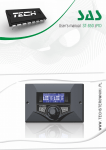

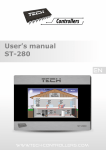
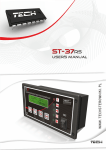
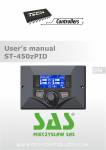

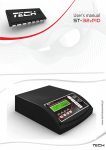

![Manuel d`utilisation Régulation TECH ST3[...]](http://vs1.manualzilla.com/store/data/006377962_1-761c4fa99f631e7c2b8551b5818edead-150x150.png)

